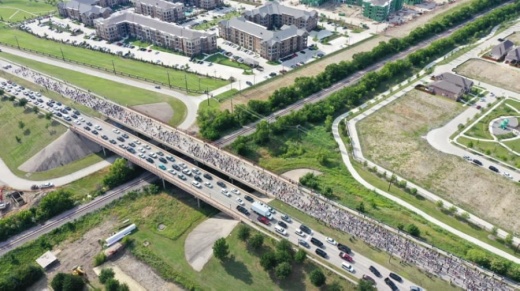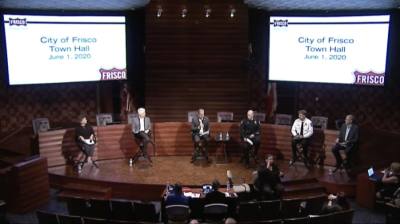Frisco's Mayor Jeff Cheney and Police Chief David Shilson were among an estimated 2,000 people participating in a peaceful march through the city Monday night to protest last week's death of a black man while in police custody in Minneapolis.
The protest was one of many held throughout the country in the days since the May 25 killing of George Floyd. But while other cities, including Dallas and Fort Worth, instituted curfews to curb the vandalism and violence occurring within their borders, the city of Frisco reported no major issues from the crowd that started at Warren Sports Complex and walked several miles along Eldorado Parkway with a police escort.
Daniel Rentie, a college ministry associate at First Baptist Church of Frisco, was one of the organizers of the march. Rentie said he was thrilled to see representatives of the city and the Frisco Police Department supporting the effort to bring attention to racism and social injustice.
"We were able to do it in large numbers, but in a peaceful way," Rentie said on June 2. "And to show cities across this country that the only way we can fight this thing is together and the best way to fight this thing is together."
Shilson described protest organizers as “very cooperative” in keeping the event peaceful.
“We saw this as an opportunity that we could show the state, the region, the nation, you can make a very impactful statement as a unified community,” Shilson said later in the evening at a Frisco Town Hall meeting.
On May 28, Shilson issued a statement claiming the actions of the police officers involved in Floyd’s death do not fall in line with the Law Enforcement Code of Ethics.
“Words from our profession are not enough,” Shilson said in the statement. “We must speak through our actions and live up to the code of ethics we swear to before putting on a badge.”
Shilson echoed a similar message at Monday's Town Hall.
“That’s what me being out there today was about,” he said. “I wanted to show this community that our department wants to send a message that we don’t condone what we saw from Minneapolis.”
Cheney reposted Shilson’s statement on Facebook May 28 and thanked him for “setting the tone from the top that the horrific death of George Floyd would never be tolerated here in Frisco.”
A few hours before the June 1 protest, Cheney posted a message on Facebook in support of those planning to participate.
“It was heartwarming. It made me proud to be the mayor,” he said afterward at the Town Hall. “Fight the darkness with the light, and that’s exactly what Frisco did today.”
The protest ended at about 9:30 p.m. June 1, according to police. Frisco Officer James Willis said there were no arrests, reported injuries or damaged properties as a result of the Frisco protest.
Shilson said violence and rioting will not be tolerated. In a “worst case scenario,” he said, Frisco Police has resources lined up with the Texas Department of Public Safety, the McKinney Police Department and other agencies.
Rentie said organizers intentionally included language in the flier for the march to explain that it would be a peaceful protest.
“At the end of the day, love is what wins, peace is what wins, and hope is what wins,” Rentie said. “I hope we were able to make a strong statement yesterday with us being able to gather in a peaceful way.”
During the Town Hall meeting, several questions came up about police protocols. One resident asked whether all on-duty Frisco Police officers are outfitted with body cameras and how often the cameras are turned on.
Shilson said all Frisco Police officers wear body cameras and have for several years. The department has a policy that requires officers to turn on body cameras during any law enforcement interaction, he said, and videos cannot be deleted.
“We’re very proactive with our supervision within our department,” Shilson said. “And we do random video reviews.”
Another resident asked about the department’s traffic stop procedures, saying she is concerned about her two black grandsons.
Shilson said officers are trained to use a seven-step violator contact method, which, according to the Texas Department of Public Safety, involves:
- greeting and identification of the agency
- statement of violation committed
- identification of driver and check of conditions of violator and vehicle
- stating of action to be taken
- taking action stated
- explaining what the violator must do
- leaving
"The tradeoff for a peaceful protest and a strong statement as a community is a good tradeoff,” Shilson said.
William C. Wadsack contributed to this report.






